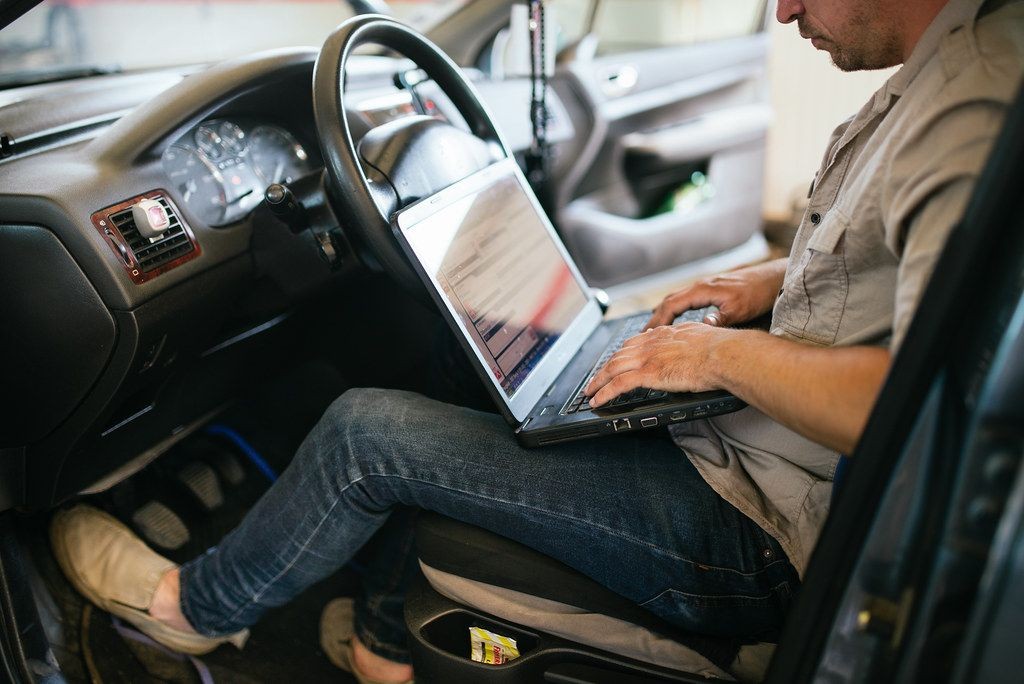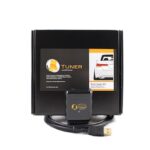Modern vehicles are technological marvels, boasting significantly more control units than cars from the 1990s. This advancement means that diagnosing car problems has become more accessible through error codes. This is where On-Board Diagnostics (OBD2) scanners become incredibly useful.
Learning how to use an OBD2 scanner can save you considerable time and money on car repairs. This guide provides essential information for the average driver to understand and utilize these tools effectively.
Understanding the Power of an OBD2 Scanner
An OBD2 scanner is a device that connects to your car’s computer system via a designated port, retrieving valuable data from its control units. This data includes diagnostic trouble codes (DTCs), also known as fault codes, and real-time information, referred to as live data. Live data encompasses sensor readings for parameters like pressure, temperature, and speed.
Alt: Technician using OBD2 scanner to diagnose car engine problem, viewing data on screen.
This information originates from various sensors throughout your vehicle. Fault codes typically arise when a sensor reading falls outside of the expected range or when a sensor becomes unresponsive.
More sophisticated diagnostic scanners offer advanced functionalities like performing service resets and even coding, which is necessary when replacing certain components in today’s cars.
OBD2 compliance became mandatory for all cars manufactured in the United States from 1996 onwards and in Europe from 2004, making these scanners universally applicable to modern vehicles.
Exploring Different Types of OBD2 Scanners
The market offers a wide array of OBD2 scanners to suit various needs and budgets.
For basic diagnostics, a Bluetooth OBD2 code reader paired with a smartphone app is the most affordable and user-friendly option. These compact devices are inexpensive and capable of reading fault codes and displaying basic live data, making them an ideal choice for everyday drivers wanting to understand their car’s basic health.
Drivers who prefer to handle DIY repairs will find that investing in a more capable handheld OBD2 scanner is beneficial. These scanners, typically starting around $100 and increasing in price with added features, can reset maintenance lights, activate service procedures like retracting electronic parking brakes for brake pad replacement, and access a broader range of live data parameters.
Professional mechanics often require even more advanced tools. While standard OBD2 scanners are helpful, they pale in comparison to professional-grade OBD2 diagnostic tools. These advanced systems provide extensive coding and programming capabilities, essential for complex repairs and module replacements.
With the right professional tools, an experienced automotive technician can customize virtually every programmable setting within a modern vehicle. However, these professional-level scanners can cost thousands of dollars and are generally too complex for the average car owner to operate.
Step-by-Step Guide: How to Use an OBD2 Scanner to Read Fault Codes
Reading fault codes is the primary function and a crucial first step in OBD2 diagnostics. If you want to effectively use an OBD2 scanner, learning this process is paramount.
While the specific controls can vary between different scanner models, the fundamental procedure remains consistent.
1. Locating the OBD2 Port and Connecting Your Scanner
Every modern car is equipped with an OBD2 port. This port is usually found beneath the steering wheel column or within the center console area. It is often concealed by a small plastic cover. Locate this port in your vehicle.
Alt: Diagram showing the common location of the OBD2 port under the dashboard of a car.
Once located, plug your OBD2 scanner securely into the port. For Bluetooth-enabled scanners, ensure it is properly paired with your smartphone or chosen device.
2. Turning On the Ignition (Powering the Car’s Systems)
OBD2 scanners require the car’s ignition to be turned on to communicate with the vehicle’s computer. Before initiating a scan, turn the ignition to the “ON” position. To minimize battery drain during the diagnostic process, it’s advisable to turn off unnecessary electrical loads like headlights, the radio, and the air conditioning.
In most vehicles, fault code scanning can be performed with the engine either running or off, as fault codes are stored in the computer’s memory until manually cleared. However, starting the engine may be necessary when analyzing live data to observe real-time sensor readings under operating conditions.
3. Identifying Your Vehicle for Accurate Diagnosis
Once the scanner is connected and the ignition is on, you will typically need to input your vehicle’s information into the scanner. This usually involves selecting the car’s make, model, and year. This step is vital as it allows the scanner to correctly identify the vehicle’s specific control units and interpret the data accurately.
Many modern scanners are equipped with an automatic VIN (Vehicle Identification Number) recognition feature. This system automatically detects your car’s VIN, retrieving and configuring the necessary vehicle information. If automatic VIN detection fails, you can also manually enter the VIN.
4. Initiating the Scan for Fault Codes
After vehicle identification, navigate to the fault code reading option within your scanner’s menu. Most scanners provide the choice to scan specific control units or perform a comprehensive scan of all accessible modules.
If you are unsure about navigating the scanner’s menu, consult the device’s built-in help section or the user manual for step-by-step instructions.
The duration of a full system scan can range from a few seconds to several minutes, depending on the car model and the number of control units being scanned.
5. Interpreting and Understanding the Revealed Fault Codes
The fault codes displayed after the scan are the key to understanding why warning lights might be illuminated on your dashboard. Some fault codes are straightforward. For example, a code like “C0031- Right Front Wheel Speed Sensor Circuit” clearly indicates a problem with the right front wheel speed sensor.
However, the underlying causes of fault codes can often be more complex than they initially appear. Consider the common code “P0171 – System Too Lean (Bank 1)”. While it points to a lean fuel mixture, the root cause could range from a clogged fuel filter or failing fuel pump to a vacuum leak, faulty sensors, or various other issues.
Utilizing Live Data for Enhanced Diagnostics
Beyond fault codes, the ability to read live data significantly enhances diagnostic capabilities. Most control units within your car offer a live data section, allowing you to monitor sensor readings in real-time. How can this be helpful?
Imagine your car is experiencing a noticeable power loss, and the only fault code present indicates “limp mode” activation. By examining live data, you can verify if parameters like fuel pressure, boost pressure (if applicable), intake airflow, and intake manifold pressure are within normal operating ranges. Deviations from expected values can pinpoint the source of the problem.
Alt: Car owner using a handheld OBD2 scanner to check live engine data for diagnosis.
However, even with access to both fault codes and live data, accurately diagnosing complex automotive issues can be challenging. You may still need to consult repair manuals or seek professional assistance to correctly interpret the data and identify the necessary repairs.
OBD2 Scanners: An Indispensable Tool When Buying a Used Car
The used car market can present potential pitfalls for buyers. Unscrupulous sellers may attempt to sell vehicles with hidden histories, electrical problems, or even legal encumbrances.
While vehicle history reports can provide valuable background information, a thorough pre-purchase inspection is crucial to avoid unexpected and costly repairs.
Before purchasing any used vehicle, it is highly recommended to obtain a vehicle history report and, importantly, to check for fault codes using an OBD2 scanner. If you do not own a scanner or are unfamiliar with how to use one, it is wise to take the car to a qualified mechanic for a professional pre-purchase inspection.
Clearing Fault Codes: Use with Caution
Scanning and reading fault codes is a diagnostic step. Fault codes themselves rarely directly indicate the solution. Even when a diagnostic scan points to a faulty mass airflow sensor, experienced technicians will typically test the sensor with a multimeter to confirm the diagnosis before replacing parts. Fault codes can sometimes be triggered by issues like damaged wiring, loose connections, or corrosion, rather than a faulty sensor itself.
After identifying and rectifying the underlying problem, it’s essential to clear the fault codes using your OBD2 scanner and then rescan to ensure the code does not reappear. If the fault code is gone, the issue is likely resolved.
By understanding how to use an OBD2 scanner, you can empower yourself to take a more proactive role in car maintenance, potentially saving money and gaining valuable insights into your vehicle’s health.

